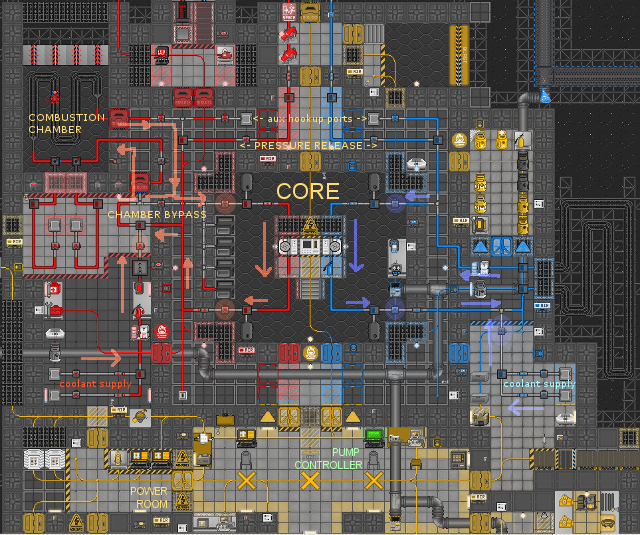Powering the station
How It All Works
The engine has three segments:
- the hot loop, where heat is generatedby heating gas in the furnaces, the combustion chamber or using a mixture that creates fire right in the pipes.
- the cold loop that absorbs heat and radiates to space.
- the generator which transfers heat from the hot to the cold loop and produces power.
Four pumps around the loop keep the gas flowing. Toggling their speed can help to regulate the power output, or fix a pressure imbalance that is blocking gas flow within a loop.
Each canister hookup has its own pump, to increase or decrease the speed of gas injection of into a loop.
The vents at the north side of engineering allow you to remove excessive pressure or scrub a loop of unwanted gas.
Gas
Gas has some important properties, pressure temperature and heat capacity.
- Pressure directs the gas flow from higher to lower pressure pipe segments. If pressure it too high in a pipe, pumps will not be able to move gas, and power output will drop.
Above 17,000Kpa pipes have a chance to burst! Check the meters, and use your pda or an analyzer on a pipe to read its pressure.
- Temperature causes gas to increase or decrease in pressure. Very little gas when heated can reach gigantic pressure. Conversely, gas in the cold loop will most often be at a low pressure.
- Heat capacity is different for each gas, it determines how quickly a gas can absorb and transfer heat.
Any gas can be used as a medium in both pipe loops; and each gas has a different ability to retain heat or transfer it more quickly. Generally, safer gases will yield much lower power outputs.
Experimenting with different gas in each loop will let you discover which combinations work best, and how to control the most dangerous gas mixtures.
Pressure
The engine can be efficiently run on very small quantities of gas. Filling the pipes with entire canisters of gas will increase the chance of pressure issues. Injecting small quantities of gas in the loops and the combustion chamber over time, reduces waste and allows for very high power outputs.
Too high pressure inside a pipe will cause it to fracture and leak gas. A broken pipe can be repaired by welding.
Pressure imbalances that stop the correct flow of gas can be controlled by venting gas (either to a canister, or to space). Venting is more effective when gas flow is temporarily blocked by shutting down the proper valve or reducing the pressure of the closest pump.
